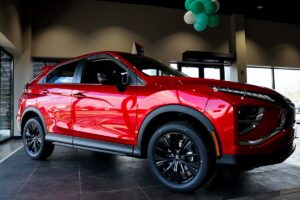A plug-in hybrid (PHEV) car is a car equipped with both a combustion engine and an electric motor. The electric motor is powered by a battery that you charge by connecting the car to the mains, in most cases this will be a charging station. So a PHEV is a car that allows you to drive both (fully) electric and fuel.
What hybrid varieties are there?
There are three different types of hybrid cars:
- Mild hybrid: a mild hybrid car is a car that combines a combustion engine with a small electric motor. The electric motor is powered by a small battery charged by the combustion engine and by braking energy recuperation. Mild hybrid cars do not have a plug, so they cannot be charged from the mains.
- Full hybrid: a full hybrid car is a car that combines a combustion engine with an electric motor. The electric motor can drive the vehicle independently, but the combustion engine is also used to charge the battery. Full hybrid cars have a plug that you have to use to charge them.
- Plug-in hybrid: a plug-in hybrid car has a battery large enough to drive the vehicle a certain distance on electric power. This range is often limited and varies from brand to brand. However, you can charge the battery using a cable and a charging pole. You see this model more and more often on Dutch roads.
Mitsubishi hybrid models
The Mitsubishi Eclipse Cross PHEV and the Mitsubishi ASX PHEV are both plug-in hybrid cars. We briefly discuss both models below:
Eclipse Cross PHEV
 With Super-All Wheel Control (4WD), this car offers excellent grip and control on any type of terrain. The combined power of 138 kW (188 hp) and maximum towing weight of 1,500 kg make this car perfect for daily use and adventurous trips. With fuel consumption of just 2.0 l/100 km (combined, WLTP) and an electric range of 45 km (WLTP), this car is also very efficient.
With Super-All Wheel Control (4WD), this car offers excellent grip and control on any type of terrain. The combined power of 138 kW (188 hp) and maximum towing weight of 1,500 kg make this car perfect for daily use and adventurous trips. With fuel consumption of just 2.0 l/100 km (combined, WLTP) and an electric range of 45 km (WLTP), this car is also very efficient.
ASX
The new Mitsubishi ASX combines a spacious feel with advanced driving assistance systems, a high level of driving comfort and is available with different powertrains: petrol, Mild Hybrid (MHEV), Full Hybrid (HEV).
Power ranges from 91 to 159 hp, and with a maximum towing weight of 1,500 kg (1.3 DI-T 7DCT), this car is also suitable for towing heavy loads. With fuel consumption (combined, WLTP) ranging from 1.3l/100km to 5.9l/100km, this car is also very efficient.
Difference between hybrid and all-electric?
The main difference between a fully electric car and a hybrid car is that a hybrid car also has an internal combustion engine. This means that a hybrid car has a greater range than a fully electric car. However, a fully electric car can drive more economically than a hybrid car because there is no combustion engine wasting energy.
Hybrid cars are a good choice for people who want to save on fuel costs and reduce CO2 emissions. Plug-in hybrid cars are a good choice for people who often drive short distances and want to enjoy the benefits of an electric car.
